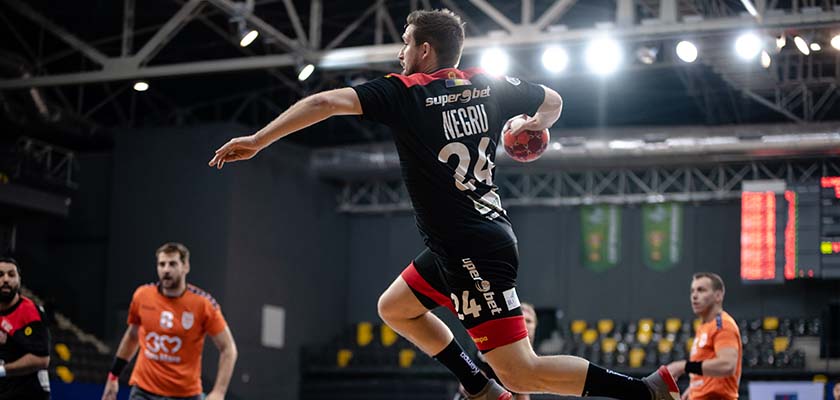Handball is an exciting and dynamic sport that involves two teams competing to score goals by throwing a ball into a goal. In addition to the individual skills of the players, teams also employ different handball tactical systems to gain an advantage over their opponents.
Handball’s tactical systems are playing strategies that teams use to organize their players on the court, both in defense and attack.
They are like a game plan that involves the movement of players and specific moves to score goals and defend one’s own goal.
Let’s explore some of handball’s tactical systems!
Participate in our free Whatsapp community and receive daily tips, news and trivia on over 50 sports! Click here to join.
Main handball tactical systems
In handball, tactical systems are like game strategies that teams use to overcome their opponents;
These systems help to create space, block opposition attacks and maximize the chances of scoring goals.
There are several tactical systems in handball, each with its own characteristics and ways of being applied.

Handball tactical systems: defense
As in most sports, there are tactical systems in handball for defending and attacking. In this first moment, our focus will be on the former.
Defensive zones in handball
- Defensive Position 1, located at the left and right ends of the court, is positioned near the junction between the back line and the sideline, with the main players responsible for marking the opposition’s wingers;
- Defensive Position 2, also located at the left and right ends of the court, is a little more centralized compared to position 1, and is mainly responsible for marking the opposing midfielders;
- Defensive Position 3, also at the left and right ends of the court, is responsible for marking in the central region, and is known as the base defensive position, with the function of marking the opposing team’s central midfielder and pivot;
- The Goalkeeper, the last line of defense in Handball, has the task of defending shots towards the goal and guiding the team’s defensive positioning.
Zone defense 6:0
The 6:0 zone defense is a very popular strategy in handball and serves as the basis for other tactics. In this system, the players organize themselves into zones, forming a 6-metre defensive line, leaving only the goalkeeper outside this barrier.
Each defensive player is responsible for a specific area and the marking is adjusted according to the movement of the ball.
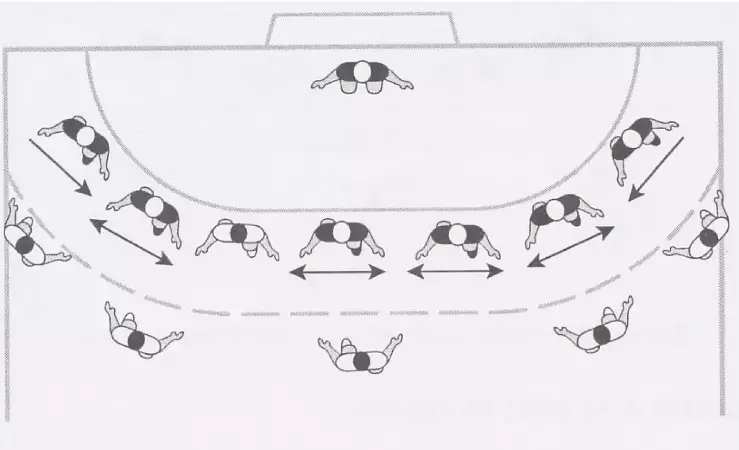
Zone defense 6:0 – Photo
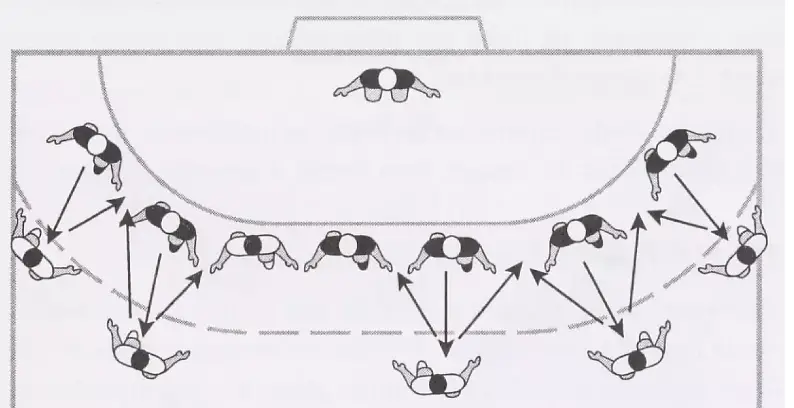
Defesa em zona 6:0 com flutuação ativa – Foto
There are no fixed positions, so players have to move constantly, either back and forth or laterally, depending on where the ball is being played by the opposing team.
The advantages of this system include the difficulty for opponents to penetrate the defense and limiting the movements of the opposing pivot, which makes shooting more difficult.
Zone defense 5:1
In the 5:1 zone defense, five players are positioned in the first or second defensive line, each with the task of preventing passes and infiltrations by the opposing team.
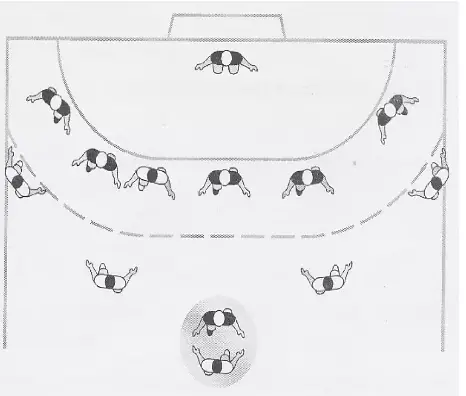
Zone defense 5:1 – Photo
This system is especially useful against teams with good close and long throwers, as well as a good game organizer.
Zone defense 4:2
In the 4:2 zone defence, the team is divided into two defensive lines, with two players near the nine-metre mark in the first line and four near the six-metre mark in the second.
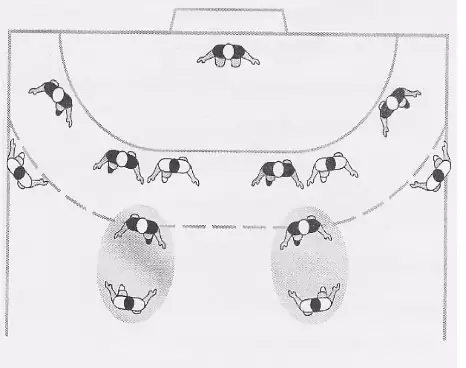
Defense in 4:2 zone – Photo
This tactic aims to prevent medium- and long-distance shots, with the players in the second line moving laterally, back and forth, and diagonally.
3:2:1 system
The 3:2:1 system involves three defensive lines, with the first made up of the full-backs and central defenders close to the six-metre area, the second by the wingers and the third by the advanced defender on the nine-metre line.
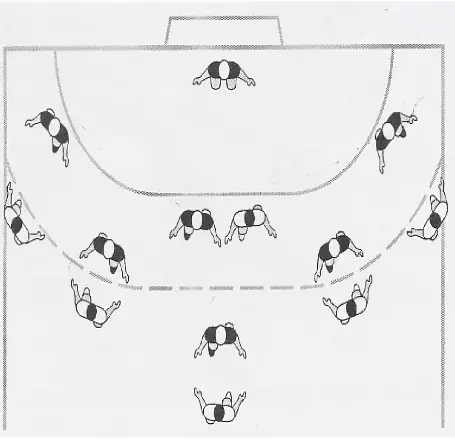
3:2:1 System – Photo
One of the advantages of this system is that it facilitates counter-attacks.
List of handball tactical systems: defense
- Zone defense 6:0
- Zone defense 5:1
- Zone defense 4:2
- 3:2:1 system
Handball tactical systems: attack
Now let’s explain the offensive tactical systems. Check them out:
Positional attack
Positional attacking is a system where the ball is moved quickly between players, each occupying a specific position to create spaces in the opposition’s defense and open up scoring opportunities.
Attack in circulation
The circulating attack is a popular strategy, where players constantly change positions, making it more difficult for the opposition to mark them.
Combined attack
The combined attack combines elements of the positional attack and circulation, with some players holding fixed positions while others move around the court. To be successful, attacks must be swift, avoiding being considered passive by the referee, which could result in penalties for the team.
There are also 6:0 and 5:1 attack systems.
Attack in the zone 6:0
Highly effective against 6:0, 5:1, 3:3 and 3:2:1 defensive systems. This offensive method is renowned for its simplicity.
Six players line up in front of the free kick area, trying to cover the whole area.
The interaction between them should prioritize the exchange of passes, with a view to penetration or the creation of opportunities for long-range shots.
In this strategy, there is no defined role for the pivot, and it’s up to the playmakers to lead the play from the wings.
This induces the opposition defense to move to one side, allowing the attack to exploit the space in the opposite direction.
If the set-up starts in the center of the court, the players must circulate the ball close to the dividing line, avoiding the cuts of the opposing defenders.
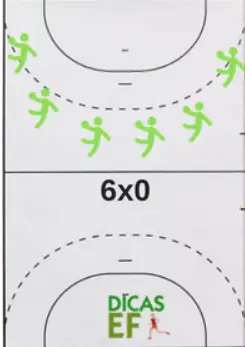
Attack in zone 6:0 – Photo.
Attack in the 5:1 zone
This strategy is effective against 6:0, 4:2, 3:3 and 3:2:1 defensive systems. Five players position themselves in front, in the free kick area, while a pivot positions himself near the goal, occupying the central region of the goal to maximize his shooting chances.
The pivot adjusts his movements according to the movement of the ball, making it easier to receive it and moving towards the play as necessary.
The five other players take on the role of setting up the play, with three of them dedicated to this specific function, while the remaining two, positioned on the edges, seek penetration into the area or offer support to the pivot in finishing and shooting.
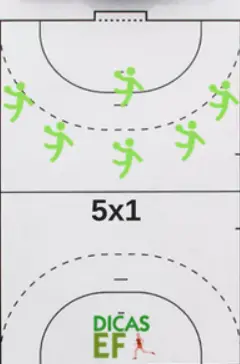
Attack on zone 5:1 – Photo.
List of handball tactical systems: attack
- Positional attack
- Attack in circulation
- Combined attack
- Attack in zone 6:0
- Attack in the 5:1 zone
What did you think of learning more about handball’s tactical systems? If you enjoyed it, read on:


